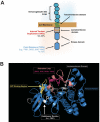Profile of Quizartinib for the Treatment of Adult Patients with Relapsed/Refractory FLT3-ITD-Positive Acute Myeloid Leukemia: Evidence to Date
- PMID: 32021432
- PMCID: PMC6955578
- DOI: 10.2147/CMAR.S196568
Profile of Quizartinib for the Treatment of Adult Patients with Relapsed/Refractory FLT3-ITD-Positive Acute Myeloid Leukemia: Evidence to Date
Abstract
Acute myeloid leukemia (AML) is a clonal hematologic neoplasm characterized by rapid, uncontrolled cell growth of immature myeloid cells (blasts). There are numerous genetic abnormalities in AML, many of which are prognostic, but an increasing number are targets for drug therapy. One of the most common genetic abnormalities in AML are activating mutations in the FMS-like tyrosine kinase 3 receptor (FLT3). As a receptor tyrosine kinase, FLT3 was the first targetable genetic abnormality in AML. The first generation of FLT3 inhibitors were broad-spectrum kinase inhibitors that inhibited FLT3 among other proteins. Although clinically active, first-generation FLT3 inhibitors had limited success as single agents. This led to the development of a second generation of more selective FLT3 inhibitors. This review focuses on quizartinib, a potent second-generation FLT3 inhibitor. We discuss the clinical trial development, mechanisms of resistance, and the recent FDA decision to deny approval for quizartinib as a single agent in relapsed/refractory AML.
Keywords: AML; FLT3; QuANTUM; clinical trials; quizartinib; resistance.
© 2020 Fletcher et al.
Conflict of interest statement
Dr. Elie Traer reports consulting honorarium from Astellas, Agios, Daiichi Sankyo, Abbvie, and ImmunoGen, outside the submitted work. The authors report no other conflicts of interest in this work.
Figures

Similar articles
-
Quizartinib (AC220): a promising option for acute myeloid leukemia.Drug Des Devel Ther. 2019 Apr 8;13:1117-1125. doi: 10.2147/DDDT.S198950. eCollection 2019. Drug Des Devel Ther. 2019. PMID: 31114157 Free PMC article. Review.
-
Practical Considerations for Treatment of Relapsed/Refractory FLT3-ITD Acute Myeloid Leukaemia with Quizartinib: Illustrative Case Reports.Clin Drug Investig. 2020 Mar;40(3):227-235. doi: 10.1007/s40261-019-00881-7. Clin Drug Investig. 2020. PMID: 31912423 Free PMC article. Review.
-
Emerging treatment paradigms with FLT3 inhibitors in acute myeloid leukemia.Ther Adv Hematol. 2019 Feb 15;10:2040620719827310. doi: 10.1177/2040620719827310. eCollection 2019. Ther Adv Hematol. 2019. PMID: 30800259 Free PMC article. Review.
-
Quizartinib versus salvage chemotherapy in relapsed or refractory FLT3-ITD acute myeloid leukaemia (QuANTUM-R): a multicentre, randomised, controlled, open-label, phase 3 trial.Lancet Oncol. 2019 Jul;20(7):984-997. doi: 10.1016/S1470-2045(19)30150-0. Epub 2019 Jun 4. Lancet Oncol. 2019. PMID: 31175001 Clinical Trial.
-
Efficacy and safety of quizartinib in Japanese patients with FLT3-ITD positive relapsed or refractory acute myeloid leukemia in an open-label, phase 2 study.Int J Hematol. 2019 Dec;110(6):665-674. doi: 10.1007/s12185-019-02727-6. Epub 2019 Aug 31. Int J Hematol. 2019. PMID: 31473943 Clinical Trial.
Cited by
-
The Flt3-inhibitor quizartinib augments apoptosis and promotes maladaptive remodeling after myocardial infarction in mice.Apoptosis. 2024 Apr;29(3-4):357-371. doi: 10.1007/s10495-023-01911-8. Epub 2023 Nov 9. Apoptosis. 2024. PMID: 37945814 Free PMC article.
-
Recent advances of targeted therapy in relapsed/refractory acute myeloid leukemia.Bosn J Basic Med Sci. 2021 Aug 1;21(4):409-421. doi: 10.17305/bjbms.2020.5485. Bosn J Basic Med Sci. 2021. PMID: 33577442 Free PMC article. Review.
-
Cardiotoxicity in Acute Myeloid Leukemia in Adults: A Scoping Study.Cancers (Basel). 2024 Jul 6;16(13):2474. doi: 10.3390/cancers16132474. Cancers (Basel). 2024. PMID: 39001536 Free PMC article. Review.
-
Mapping the proteogenomic landscape enables prediction of drug response in acute myeloid leukemia.Cell Rep Med. 2024 Jan 16;5(1):101359. doi: 10.1016/j.xcrm.2023.101359. Cell Rep Med. 2024. PMID: 38232702 Free PMC article.
-
Oncoproteomic profiling of AML: moving beyond genomics.Expert Rev Proteomics. 2022 Jul-Dec;19(7-12):283-287. doi: 10.1080/14789450.2023.2176757. Epub 2023 Feb 10. Expert Rev Proteomics. 2022. PMID: 36734985 Free PMC article. No abstract available.
References
Publication types
Grants and funding
LinkOut - more resources
Full Text Sources
Research Materials
Miscellaneous

